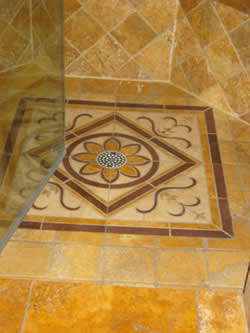
South Florida's Premier Selection of Natural Stone & Marble
Click Here for Information on StainMaster Stone
Experience our expert service as you browse one of South Florida’s best selections of natural stone and marble tile at Capitol Carpet & Tile!

The beauty of natural stone and marble is unsurpassed. At Capitol Carpet & Tile, we have a wide selection of patterns, textures, sizes and colors. No matter what the decor or color scheme, South Florida residents can find the perfect natural stone and tile for their home decorating.
Because Capitol only uses top-quality installers, Lou Morano, president and owner, stands behind every installation and he guarantees the lowest price. Various styles, colors and sizes at fantastic savings. We have one of the largest selections in South Florida of granite, marble, travertine, limestone, slate and much more.
Common Stone Types
Scientific versus Commercial Definition
Stones, and the minerals of which they are composed, have been studied with keen interest in the earth science fields for centuries. Geology is the study of the formation and history of the earth, while petrography is the study of rocks and the minerals of which they're made. Geologists and petrographers worldwide have defined hundreds of different rock types, based on their mineral composition, texture, and method of formation. Commercially, the use of the exact scientific rock definition would be a cumbersome and unnecessarily complicated practice. Furthermore, there are many rocks which are not clearly within one definition or another, but rather "straddling the fence" between two definitions. This point is further elaborated by the U.S. Geological Survey (USGS).
Department of the Interior:
Scientific and commercial descriptions of various dimension stone types overlap. The scientific description of dimension stone types is focused primarily on the stone's geographic locality and mineralogical composition, whereas the commercial description is focused primarily on the locality and color of the stone.
Historically, it has been commercial practice to group stones within performance and behavioral groups as opposed to true scientific definition. This is recognized in several in ASTM International standards. While scientifically there are hundreds of rock type identifications, only nine groups are commonly acknowledged commercially: Granite, Limestone, Marble, Onyx, Quartzite, Sandstone, Serpentine, Slate, Soapstone, and Travertine. This means that some rocks are included in groups which are not perfectly coincident with their scientific definition. High density and/or partially metamorphosed limestones, especially those capable of taking a polish, are oftentimes included in the marble group, because they appear, behave and perform more similarly to marble than to limestone. Most igneous rocks, such as gabbro, diabase, anorthosite, sodalite, gneiss, basalt, and many others are included in the granite group because they behave and perform similarly to granite. There are even a few non-igneous rocks (e.g. silicate-based conglomerates) that are commercially grouped with granites. Therefore, if you purchase a Crema Marfil "marble" vanity top, don't be surprised if your geologist friend visits your home and insists that it is limestone, because scientifically it is. Likewise, don't be surprised of the same geologist friend informs you that your Paradisio "granite" bar top and your Absolute Black "granite" kitchen island are really gneiss and gabbro respectively, because scientifically that's what they are. The key is performance. If a rock is sold within the granite group, the rock should be expected to have performance in that application that is similar, or in some cases superior, to that of a true granite.
The informed selection of natural stone products is also influenced by the tastes of the end user. To some, natural wear, etching, or weathering bring about a hidden charm, or natural "patina" as the stone displays signs of its yielding to the forces encountered in its service. To others, the only acceptable performance is for the stone to maintain its pristine, "as new" look for the entire duration of its service life. Selections of natural stone types are available to satisfy both users, but the proper research must be completed to assure that the selected stone will perform in service with the desired behavior.
Granite:
An excellent choice for kitchen countertops,
floors, and other heavily used surfaces
Exact and current extraction figures are not available, as data collection from many countries is difficult. Statistics from various sources indicate that the granite quarried in the countries of China, India, and Brazil comprises approximately 2/3 of the granite used worldwide. There are granite quarries in operation in dozens of countries, and it is one of the most popular natural stones on the market. New granite resources are continually being located and developed throughout the world.
Granite has long enjoyed use as an exterior cladding and pavement material, and its inherent strength, abrasion resistance and superior weathering durability are likely to keep it one of the preeminent material selections available to today's architects. Granite has also been employed as the traditional material for municipal curbs, where its strength and durability have been documented with decades of vehicular abuse. In the northern climates where snow melting chemicals are used heavily, granite has resisted the attack of these caustic agents.
Being one of the hardest of the dimension stone types, granite was historically avoided by the smaller, local stone fabricating shops, who favored marbles and limestones due to their easier working properties. A recent boom in the supply of affordable machinery and abrasives technologies eliminated these previous difficulties in fabrication. The use of granite has skyrocketed in residential interior applications as a result. Available in a striking array of colors, granite's durability, longevity, and economy make it ideal for kitchen countertops and other heavily used surfaces, including table tops and floors.
Marble & Onyx:
Ideal for foyers, bathrooms, floors and hearths
Marble is a metamorphic rock found in the mountainous regions of most countries of the world. Marble quarried in India, China, Italy, and Spain represents the majority of marble, in terms of volume, that is utilized worldwide. Because of its beauty and elegance, marble is a popular choice for countertops, floors, foyers, fireplace facings and hearths, walls, and windowsills.
Marble with its inherent warmth, adds a sophisticated element to the area in which it is installed. Its naturally random appearance, engineering characteristics, and ease of maintenance makes it a premium choice for floors, wall claddings, table tops, wainscot, floors, and vanity tops. Many marbles are well suited for wet area application, which extends the versatility of this material to include tub decks and showers.
The calcite crystal is the basic building block of true marbles. The calcite crystal is vulnerable to attack by mild acids, including those commonly found in kitchen and bar settings. The user selecting marble for these applications should be aware of, and accepting of the maintenance and patina that is to be anticipated with this combination. Acid rain and other weathering elements can also affect exterior marble installations, and exterior applications are generally limited to white marbles, with some exceptions.
Onyx is often confused with marbles, yet it is a significantly different rock type. Onyx is a sedimentary rock, formed as stalactites and stalagmites in cave interiors. This formation method results in the cryptocrystalline construction of the rock fabric, and it is the size and uniformity of these crystals that contribute to the classic translucent property of most onyx varieties. While vulnerable to chemical and abrasive attack, the decorative appeal of onyx is perhaps unsurpassed by any other material.
Slate and Soapstone:
Versatile, Chemically Resistant Materials
A traditional use of both these materials was the laboratory table top in chemistry labs. That application alone should serve as a great testimonial to the chemical resistance of the materials.
Being of the softer varieties of dimension stone types, neither of these materials is known for particularly high abrasion or scratch resistance, yet they are both used a flooring and countertop products.
Soapstone is highly heat resistant, and has been used in fireplace surrounds frequently to take advantage of this property.
Slate, being of laminar construction, has the ability to be processed into thin sheets and still maintain serviceable strength and rigidity. This property makes slate the only dimension stone having been used for blackboards and roofing shingles. It was also traditionally used as the cloth-covered playing surface of billiards tables.
Travertine and Limestone,
An earthy appeal, indoors and out
Limestone deposits exist in all continents of the earth. Despite the common and traditional reference to "travertine marble", travertine is really a type of limestone. It is actually the terrestrial (land) formed version of limestone, as opposed to the marine based formations of many other limestone varieties.
Featuring their soft earth tones, decorators integrating these stones into their design have great flexibility in selecting complimentary colors for other interior elements.
Many varieties of both materials have enjoyed a successful history of exterior application, and some of the most prominent government and financial institutions worldwide proudly display limestone as their exterior cladding. Despite the popularity of exterior vertical limestone applications, the number of limestone varieties with successful history in exterior paving applications, particularly in freeze/thaw environments, is relatively limited.
Since these stones are some of the softer varieties of natural stone materials, they have long been a popular choice for intricately carved features and moldings, as well as statuary.
Click Here to View Our Tile Magazine
Click here to send us an email to request the 100 page full color custom tile design magazine. |
![]()
 |
Ask About Our Shop At Home Service! |
||
 Contact Us!
Contact Us!
 Need to contact us? Click here for complete contact information, a map of our locations & more!
Need to contact us? Click here for complete contact information, a map of our locations & more!
![]() (800) 567-4020
(800) 567-4020
![]()
For Commercial Inquiries Call:
![]() (561) 533-9800 x 126
(561) 533-9800 x 126


